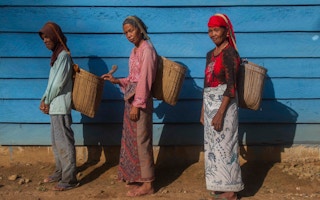Dahniar starts worrying after a few days without rain during the dry season here on the northeast coast of Sumatra.
Traders selling water will complain of supplies drying up. Even Dahniar’s neighbors are reluctant to sell their water when the heat is on and anxiety begins to drip through Kuala Selat village.
“It’s difficult if there’s no water — it’s even hard to buy,” Dahniar, a small business owner in her 50s, told Mongabay Indonesia.
Indonesia’s meteorology agency, the BMKG, recorded a months-long drought last year across most of the archipelagic nation. The 2023 dry season was exacerbated by the El Niño and positive Indian Ocean Dipole climate patterns, leaving much of Sumatra praying for rain well into October.
Across the world, climate change is worsening the water stress felt in villages like Kuala Selat. Some 436 million children live in areas of high or extreme water stress, while three-quarters of all natural disasters from 2001-2018 were water-related, according to UNICEF, the United Nations’ children’s fund.
Kuala Selat and other communities lacking access to piped water or viable wells are sustained mainly by the rain. A jerrican of rainwater here fetches between 15,000 and 80,000 rupiah (roughly US$1-US$5) depending on the size of the drum. And some families go to significant lengths to ensure they will meet their basic needs.
Kuala Selat resident Abdul Rahman owns 20 large water drums to catch enough rainwater on his land to last the dry months ahead. Dani Sartika, the principal of the An-Nur Islamic boarding school here, said he has to procure water for the school’s 70 students from people who live nearby, like Suryati.
“For those who can’t afford it, sometimes they’ll ask us,” Suryati said. “If we know they’re hard up, we give it away for free.”
Those with means will make calls to traders selling 19-litre (5-gallon) water bottles. Others will travel two or three hours by boat to the Penjuru River to collect water, ensuring that they journey far enough from the coast that the water is not brackish.
Most families in Indonesia count on wells bored several meters into the aquifer for water. However, many coastal communities can’t rely on this method owing to saltwater intrusion or excess iron in the aquifer.
Doing the laundry using groundwater in Kuala Selat will turn clothes the colour of rust.
“Because the iron content is high, the water is yellow — it’s the people’s habit still to consume rainwater rather than [bottled] water,” said Rony Fahamsya, secretary of the Indragiri Hilir district planning agency, Bappeda.
There’s no sewage network in Kuala Selat, and Suryati said she suspects the water crisis is linked to bouts of diarrhoea, the leading cause of child mortality in Indonesia. Every day, more than 1,000 children around the world die due to diarrhoea.
When an outbreak occurs, some residents will pack up and stay with family outside Kuala Selat.
Unsustainable
The sixth of the 17 Sustainable Development Goals adopted by the United Nations in 2015 — and to be achieved by 2030 — aspires to ensure access to “clean water and sanitation for all.”
Like more than 500 other district and city governments across Indonesia, Indragiri Hilir is working toward that goal by supporting the local water utility and drilling wells for outlying communities.
The district utility, known as PDAM Tirta Indragiri, serves only households in the district seat and lacks the capital needed to pipe water 80 kilometres (50 miles) across the region’s characteristic peat swamps to places like Kuala Selat.
That leaves Indonesia’s community water and sanitation program, known as Pamsimas, a lifeline for water-stressed villages.
Since 2008, the national program has provided a source of drinking water to 22.1 million people in 31,7000 villages (the program also brought basic sanitation to 15 million people). The World Bank assessed that 81 per cent of villages in the Pamsimas program were free from open defecation in 2021.
“Almost all villages have the Pamsimas service,” Indragiri Hilir’s Rony said.
But Kuala Selat isn’t adequately covered by the initiative. The neighbouring village of Tagaraja, around 15 km (9 mi) north of Kuala Selat, has a 14-hectare (35-acre) reservoir of water. However, the capacity has become increasingly strained under drought and the local government says it can’t expand supply from Tagaraja.
The Indragiri Hilir government says it will likely cost tens of billions of rupiah to fix the problem, potentially millions of dollars.
Drilling a one-off well with the necessary filtration system would cost up to 250 million rupiah (US$15,800), but these wells can prove unsustainable for local government finances, Rony said.
“The fear is that people will not be able to buy water,” he said. “Many Pamsimas managements have also stalled because operational costs are not commensurate with the cost of drinking water fees.”
The number of home water connections installed in urban areas in Indonesia was 3.5 times greater than in rural settings between 2012 and 2021.
Muhammad Reza Sahib, coordinator of the People’s Coalition for the Right to Water (KRuHA), an Indonesian civil society group, said this inequity in water access reflects years of underinvestment in public infrastructure.
“Whatever the problem is, invest in the solution,” Reza said.
In Kuala Selat, children at the Islamic boarding school wash outside their school using containers of increasingly scarce rainwater.
Abdul Rahman’s 20 large drums to collect rainwater turned out not to be enough; after two months of drought last year, his family ran out of water.
And for Dahniar, the dry season in Kuala Selat requires her to rely on her neighbours’ goodwill.
“Whether we like it or not,” Dahniar said, “we beg them instead of not being able to cook.”
This story was published with permission from Mongabay.com.








